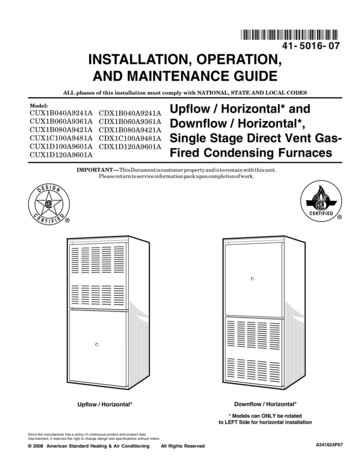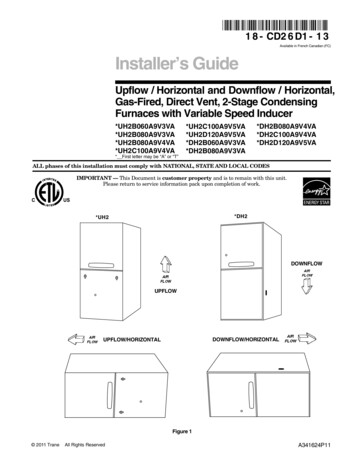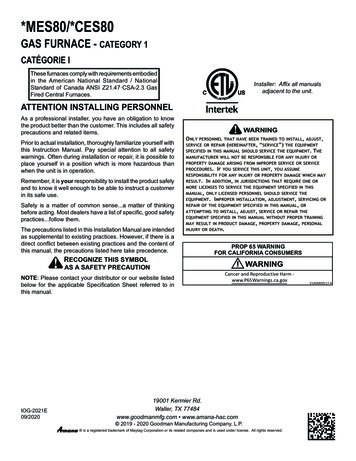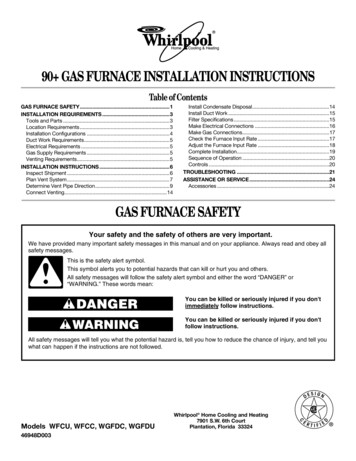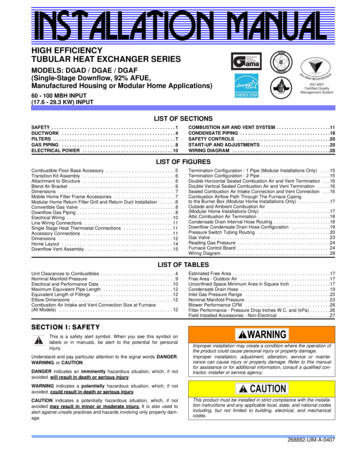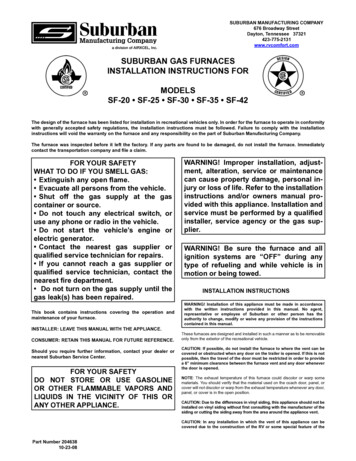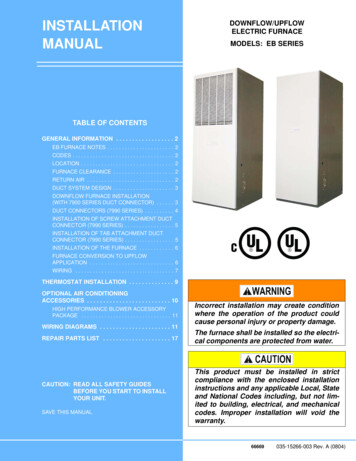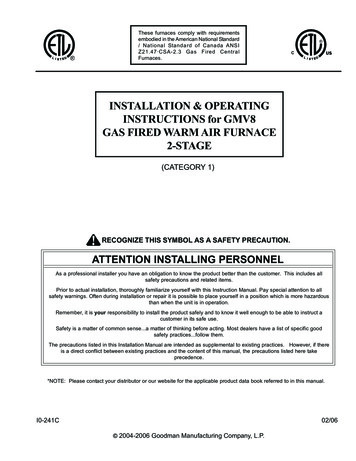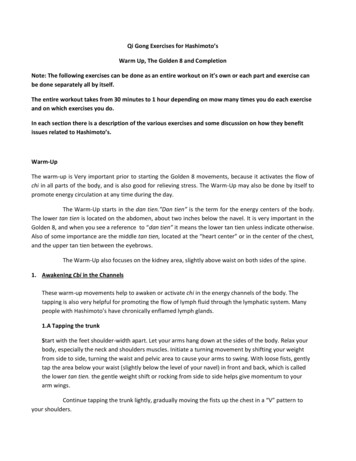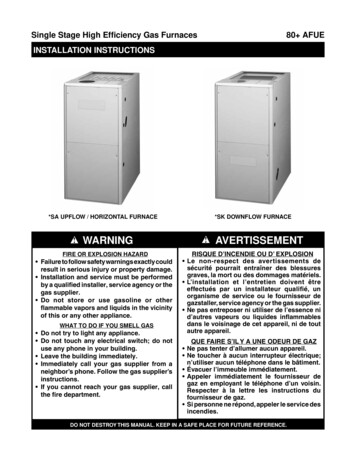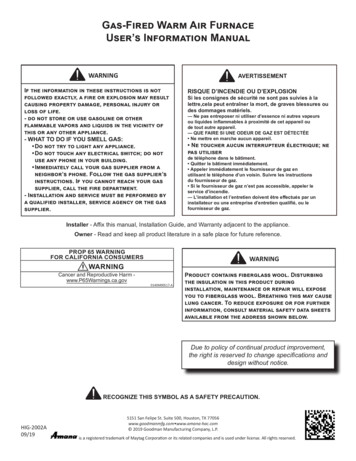
Transcription
Gas-Fired Warm Air FurnaceUser’s Information ManualWARNINGAVERTISSEMENTIf the information in these instructions is notfollowed exactly, a fire or explosion may resultcausing property damage, personal injury orloss of life.- do not store or use gasoline or otherflammable vapors and liquids in the vicinity ofthis or any other appliance.- WHAT TO DO IF YOU SMELL GAS: Do not try to light any appliance. Do not touch any electrical switch; do notuse any phone in your building. Immediately call your gas supplier from aneighbor’s phone. Follow the gas supplier’sinstructions. If you cannot reach your gassupplier, call the fire department.- Installation and service must be performed bya qualified installer, service agency or the gassupplier.RISQUE D’INCENDIE OU D’EXPLOSIONSi les consignes de sécurité ne sont pas suivies à lalettre,cela peut entraîner la mort, de graves blessures oudes dommages matériels.— Ne pas entreposer ni utiliser d’essence ni autres vapeursou liquides inflammables à proximité de cet appareil oude tout autre appareil.— QUE FAIRE SI UNE ODEUR DE GAZ EST DÉTECTÉE Ne mettre en marche aucun appareil. Ne toucher aucun interrupteur électrique; nepas utiliserde téléphone dans le bâtiment. Quitter le bâtiment immédiatement. Appeler immédiatement le fournisseur de gaz enutilisant le téléphone d’un voisin. Suivre les instructionsdu fournisseur de gaz. Si le fournisseur de gaz n’est pas accessible, appeler leservice d’incendie.— L’installation et l’entretien doivent être effectués par uninstallateur ou une entreprise d’entretien qualifié, ou lefournisseur de gaz.Installer - Affix this manual, Installation Guide, and Warranty adjacent to the appliance.Owner - Read and keep all product literature in a safe place for future reference.PROP 65 WARNINGFOR CALIFORNIA CONSUMERSWARNINGWARNINGCancer and Reproductive Harm www.P65Warnings.ca.gov0140M00517-AProduct contains fiberglass wool. Disturbingthe insulation in this product duringinstallation, maintenance or repair will exposeyou to fiberglass wool. Breathing this may causelung cancer. To reduce exposure or for furtherinformation, consult material safety data sheetsavailable from the address shown below.Due to policy of continual product improvement,the right is reserved to change specifications anddesign without notice.RECOGNIZE THIS SYMBOL AS A SAFETY PRECAUTION.HIG-2002A09/195151 San Felipe St. Suite 500, Houston, TX 77056www.goodmanmfg.com www.amana-hac.com 2019 Goodman Manufacturing Company, L.P.is a registered trademark of Maytag Corporation or its related companies and is used under license. All rights reserved.
CONTENTSWARNINGImportant Note to the Owner regarding ProductLimited Warranty.3Unit Location.3Unit Installation.3Air Requirements.3Combustion Air.4Indoor Humidity.4Propane (LP) gas installations only.5Thermostat Functions.5Furnace Operation.6Routine Maintenance.6Troubleshooting / Before You Request aService Call.8Safety labels.9Should overheating occur or the gas supply failto shut off, turn off the manual gas shutoffvalve external to the furnace before turning offthe electrical supply.WARNINGTo prevent possible property damage, personalinjury or death due to electrical shock,the furnace must be located to protect theelectrical components from water.Dear Homeowner, please recognize the following safetyinformation. This information will alert you to the potentialfor personal injury.WARNING - Indicate hazards or unsafepractices which COULD result in severe personalinjury or death.WARNINGTo avoid possible equipment damage, personalinjury, fire or death, the following instructionsmust be observed regarding unit location, airrequirements and operating procedures.WARNINGHeating unit should not be utilized withoutreasonable, routine, inspection, maintenanceand supervision. If the building in which anysuch device is located will be vacant, careshould be taken that such device is routinelyinspected, maintained and monitored. In the eventthat the building maybe exposed to freezingtemperatures and will be vacant, all waterbearing pipes should be drained, the buildingshould be properly winterized, and the watersource closed. In the event that the building maybe exposed to freezing temperatures and will bevacant, any hydronic coil units should be drainedas well and, in such case, alternative heatsources should be utilized.2
IMPORTANT NOTE TO THE OWNERREGARDING PRODUCT LIMITEDWARRANTY7. Make certain the required clearances for the furnaceare always maintained. These clearances are listedon the furnace clearance label. If any questiondevelops, contact the installer of the furnace oranother qualified servicer.Your limited warranty certificate is supplied as a separatedocument with the unit installed by your contractor. Readthe limited warranty certificate carefully to determine whatis and is not covered and keep the warranty certificatein a safe place. If you are unable to locate the warrantycertificate please contact your installing contractor orcontact customer service (877-254-4729) to obtain a copy.Before using this manual, check the serial plate for propermodel identification.UNIT INSTALLATIONExamine the furnace installation to determine the following:1. All flue product carrying passages external to thefurnace (i.e. chimney, vent connector) are clear andfree of obstructions.2. The vent connector is in place, slopes upward and isphysically sound without holes or excessive corrosion.3. The return air duct connection is physically sound,sealed to the furnace casing, and terminates outsidethe space containing the furnace.4. The physical support of the furnace is sound withoutsagging, cracks, or gaps around the base so as toprovide a seal between the support and the base.5. There are no obvious signs of deterioration of thefurnace.6. Check for proper burner flame performance. Flameshould extend directly outward from burners withoutcurling, floating, or lifting off.The installation and servicing of this equipment must beperformed by qualified, experienced technicians only.UNIT LOCATION1. The furnace area and the vicinity of any other gasappliances must be kept clear and free of combustiblematerials, gasoline, and other flammable vapors andliquids. Also, do not store or use flammable itemssuch as paint, varnish, or lacquer in the area.2. Do not store or use chlorine or fluorine products(bleaches, cements, strippers, aerosols) near the unit.They can corrode the heat exchanger.3. Do not use the furnace closet as storage for brooms,mops, brushes and oily rags or cloths. The area mustbe kept clear, clean and free of lint. Furnace mustbe kept free and clear of exposed or loose insulationmaterials in the area of installation. Examine thefurnace area when the furnace or additional insulationis added since some insulation materials may becombustible.4. Make sure the furnace is always connected to anapproved vent, in good condition, to carry combustionproducts outdoors.5. Familiarize yourself with the controls that shut off thegas and electrical power to the furnace. If the furnaceis to be shut down at the end of the heating season,turn off both the gas and electrical power. For safety,always turn the gas and electrical power off beforeperforming service or maintenance on the furnace.6. Establish a regular maintenance schedule to insureefficient and safe operation of the furnace. Thefurnace should be checked at the beginning of eachheating and cooling season by a qualified servicetechnician.AIR REQUIREMENTSWARNINGTo avoid property damage, personal injuryor death, sufficient fresh air for propercombustion and ventilation of flue gases mustbe supplied. Most homes require outside air besupplied into the furnace area.Improved construction and additional insulation in homeshave reduced the heat loss and made these homes muchtighter around doors and windows so that air infiltrationis minimal. This creates a problem to supply ventilationand/or combustion air for gas fired or other fuel burningappliances. Any use of appliances that pull air out of thehouse (clothes dryers, exhaust fans, fireplaces, waterheaters, non-direct vent furnaces, etc.) could reducecombustion air to the furnace.If fuel-burning appliances are starved for air, the flue gasesproduced may not vent outdoors properly. These fluegases may include carbon monoxide.WARNINGTo avoid personal injury or fire, minimumclearances to combustible surfaces must befollowed.3
Be aware of these air starvation signals which indicateconditions that my result in carbon monoxide or thatcarbon monoxide may be present:1. Headaches, Nausea, Dizziness, Flu-like symptoms.2. Excessive humidity, heavily frosted windows or amoist “clammy” feeling in the home.3. Smoke from a fireplace will not draw up the chimney.4. Flue gases that will not draw up the appliance ventpipe.COMBUSTION AIRCARBON MONOXIDE POISONING HAZARDSpecial Warning for Installation of Furnace or Air Handling Units inEnclosed Areas such as Garages, Utility Rooms or Parking AreasCarbon monoxide producing devices (such as automobiles, spaceheater, gas water heater, etc.) should not be operated in enclosedareas such as unventilated garages, utility rooms or parking areasbecause of the danger of carbon monoxide (CO) poisoning resultingfrom the exhaust emissions. If a furnace or air handler is installed inan enclosed area such as a garage, utility room or parking area and acarbon monoxide producing device is operated therein, there must beadequate, direct outside ventilation.The air for combustion and ventilation can also (wherelocal codes permit) be obtained from the surroundingunconfined space or louvered closet door. Observe thefollowing precautions concerning air availability: When a furnace is installed in a closet and the closetdoor is louvered, DO NOT OBSTRUCT LOUVERS.Louvers must be open and clear to provide combustionair to the furnace. When a furnace is installed in a confined space withina home and the air for combustion and ventilationenters the space through ducts from the outside, besure to routinely check the entering and outlet, grilledopenings to verify that they are always clear andclean. Do not partition off a small area around the furnaceutilizing a non-louvered door. This could obstruct thecombustion air from reaching the furnace.This ventilation is necessary to avoid the danger of CO poisoningwhich can occur if a carbon monoxide producing device continuesto operate in the enclosed area. Carbon monoxide emissions can be(re)circulated throughout the structure if the furnace or air handler isoperating in any mode.CO can cause serious illness including permanent brain damage ordeath.B10259-216RIESGO DE INTOXICACIÓN POR MONÓXIDO DE CARBONOAdvertencia especial para la instalación de calentadores ó manejadorasde aire en áreas cerradas como estacionamientos ó cuartos de servicio.Los equipos ó aparatos que producen monóxido de carbono (talcomo automóvil, calentador de gas, calentador de agua por medio degas, etc) no deben ser operados en áreas cerradas debido al riesgode envenenamiento por monóxido de carbono (CO) que resulta de lasemisiones de gases de combustión. Si el equipo ó aparato se operaen dichas áreas, debe existir una adecuada ventilación directa alexterior.INDOOR HUMIDITYRelative humidity is the amount of water vapor in theair relative to the amount the air can hold at the sametemperature. The colder the air; the less moisture it canhold. As air is warmed, its ability to hold moisture isincreased. Relative humidity is important to your health andhome as proper humidification helps reduce respiratorydifficulties and helps improve the indoor air quality.Esta ventilación es necesaria para evitar el peligro de envenenamientopor CO, que puede ocurrir si un dispositivo que produce monóxido decarbono sique operando en el lugar cerrado.Las emisiones de monóxido de carbono pueden circular a través delaparato cuando se opera en cualquier modo.El monóxido de carbono puede causar enfermedades severas comodaño cerebral permanente ó muerte.B10259-216RISQUE D’EMPOISONNEMENT AU MONOXYDE DE CARBONEA good relative humidity is one just high enough to barelystart condensation along the lower edges or lower cornersof the windows. More than that can be damaging.Avertissement special au sujet de l’installation d’appareils de chauffageou de traitement d’air dans des endroits clos, tets les garages, leslocaux d’entretien et les stationnementss.Evitez de mettre en marche les appareils produisant du monoxydede carbone (tels que les automobile, les appareils de chauffageautonome, etc.) dans des endroits non ventilés tels que lesd’empoisonnement au monoxyde de carbone. Si vous devez fairefonctionner ces appareils dans un endroit clos, assures-vous qu’il yait une ventilation directe provenant de l’exterier.Frequent fogging or excessive condensation on insidewindows indicates the indoor humidity level is too high foroutdoor weather conditions. Damage to the building mayresult if the condition persists. Condensation on insideof storm windows indicates a poor seal inside windows.Adding weather-stripping to tighten inside windows usuallycorrects this problem.Cette ventilation est nécessaire pour éviter le danger d’intoxicationau CO pouvant survenir si un appareil produisant du monoxyde decarbone continue de fonctionner au sein de la zone confinée.Les émissions de monoxyde de carbone peuvent etre recircules dansles endroits clos, si l’appareil de chauffage ou de traitement d’air sonten marche.Le monoxyde de carbone peut causer des maladies graves telles quedes dommages permanents au cerveau et meme la mort.B10259-216The following table shows the recommended maximumindoor humidity in relationship to the outdoor temperatures.Carbon monoxide or “CO” is a colorless and odorless gasproduced when fuel is not burned completely or when theflame does not receive sufficient oxygen.4
THERMOSTAT FUNCTIONSOutdoorHumidityTemperature Single -Paned Double-PanedGlassGlass 30 F30%50% 20 F20%40% 10 F15%35%0 F10%30%-10 F5%25%-20 F5%20%-30 F3%18%There are many types and styles of thermostats butoperation is usually similar. BE SURE TO BECOMEFAMILIAR WITH YOUR THERMOSTAT. The simplest typeof thermostat only starts and stops the furnace to maintainthe desired room temperature. The most widely usedtypes will control both heating and cooling functions andwill have a Fan Switch with Auto and ON settings. On Auto,the circulating air blower will cycle on/off with the furnacebut if switched to ON it will run continuously regardless ofwhether or not heating or cooling is being provided.In addition, there are thermostats which automaticallyswitch from heating to cooling mode and those with nightset back capability. The night set back, or multiple setback, type allows for a different temperature at night orduring the day when no one is at home. Programmablethermostats will allow for more control and tailoring of theheating and cooling functions. The level of this controldepends on the type of thermostat applied.PROPANE (LP) GAS INSTALLATIONS ONLYFor furnaces operating on propane gas, please review thefollowing warnings before use.WARNINGTo avoid property damage, personal injury ordeath, due to explosion or fire, install a gasdetecting warning device. Since the odorantin propane gas can be reduced by iron oxide(rust), a gas detecting warning device is the onlyreliable method to detect propane gas leaks.Room TemperatureThermostatCool/HeatTemperatureControl DialsWARNINGIf the gas furnace is installed in a basement, anexcavated area or confined space, it is stronglyrecommended to contact a propane supplier toinstall a gas detecting warning device in case ofa gas leak. Since propane gas is heavier than air, anyleaking gas can settle in any low areas orconfined spaces. Propane gas odorant may fade, making gasundetectable except with a warning device.Fan SwitchWARNINGAn undetected gas leak will create a dangerof explosion or fire. If the presence of gas issuspected, follow the instructions on the coverof this manual. Failure to do so could result inSERIOUS PERSONAL INJURY OR EATAUTOHEATONOFFONCool/HeatSwitchActionNoneSystem only cools, fancycles off and on.System only cools, fanruns all the time.System only heats, fancycles off and on.System only heats, fanruns all the time.No heating or cooling,fan runs all the time.
FURNACE OPERATIONWARNINGElectrical components are contained in bothcompartments. To avoid personal injury,electrical shock or death, do not removeany internal compartment covers. Contacta qualified servicer at once if an abnormalcondition is noticed.White-rodgers model 36G54/36J54 (two-stage)Furnace Shut DownTo shut down your furnace, follow the steps listed below.1. Set the thermostat to the lowest setting.1. Integrated control closes gas valve extinguishingflame.2. Induced draft blower is de-energized following a 15second delay. The circulator blower is de-energizedfollowing a 90, 120, 150, or 180 second delay period.3. Remove the burner compartment door.4. Move the furnace’s gas valve ON/OFF switch to theOFF position.5. Close the external manual gas shut-off valve.6. Replace the burner compartment door.Keep both doors in place except for inspection andmaintenance. An interlock switch prevents furnaceoperation if the blower door is not in place.Furnace Start-Up1. Close the external manual gas shut-off valve.2. Turn off the electrical power to the furnace.3. Set the room thermostat to the lowest possible setting.4. Remove the burner compartment door.5. This furnace is equipped with an ignition device whichautomatically lights the burner. Do not try to light theburner by hand.6. Move the furnace’s gas valve ON/OFF switch to theOFF position.7. Wait five minutes to clear out any gas. Then smell forgas, including near the floor as some types of gas areheavier than air.8. If you smell gas following the five minute waiting periodin step 7, immediately follow the instructions on thecover of this manual. If you do not smell gas after fiveminutes, move the furnace’s gas valve ON/OFF switchto the ON position.9. Replace the burner compartment door.10. Open the external manual gas shut-off valve.11. Turn on the electrical power to the furnace.12. Adjust the thermostat to a setting above roomtemperature.13. After the burners are lit, set the thermostat to desiredtemperature.Lockout ResetFurnace lockout is characterized by a non-functioningfurnace (circulator blower may be running continuously)providing a diagnostic LED code. Lockout results when afurnace control detects abnormal conditions. If the furnaceis in “lockout”, it may be reset by any of the followingmethods:1. One hour automatic reset. Control will automaticallyreset itself and attempt to resume normal operationsfollowing a one hour lockout period.2. Power interruption. Interrupt 115 volt power to thefurnace for greater than 20 seconds.3. Thermostat cycle. Interrupt thermostat signal to thefurnace for between 0 and 20 seconds.If the condition which originally caused the lockout stillexists, the control will return to lockout. If your furnacefrequently locks out, a problem exists which must becorrected. Contact a qualified servicer.ROUTINE MAINTENANCEMaintenance is to be performed by a qualified servicetechnician only. User maintenance is to be restricted tofrequent air filter changes and to ensure the warnings andnotices found elsewhere in this manual be followed. Werecommend that at a minimum system maintenance beperformed by a qualified service technician prior to thebeginning of each heating season, and if equipped with airconditioning, prior to air conditioning season.6
MotorsThe combustion air motor and indoor blower motor arepermanently lubricated and require no further lubrication.WARNINGPersonal injury or death may result fromimproper maintenance performed by untrainedpersonnel. Call your installing dealer or otherqualified service companies to perform themaintenance inspection.FiltersWARNINGTo avoid property damage, personalinjury or death, disconnectelectrical power before removingfilters or performing any othermaintenance. Never operate furnacewithout a filter installed becausedust and lint will build up oninternal parts resulting in loss ofefficiency, equipment damage orpossible fire.WARNINGHigh voltage!To avoid personal injury ordeath due to electrical shock,disconnect electrical powerBEFORE performing any service ormaintenance.A return air filter is not supplied with this furnace andcannot be installed inside the cabinet; however, a meansof filtering all of the return air (intake) must be provided.Your installer will supply filters at the time of installation.Become familiar with filter location and procedures forremoving, cleaning and replacing them.Annual InspectionThe furnace should be inspected by a qualified installer, orservice agency at least once per year. This check shouldbe performed at the beginning of the heating season bya qualified technician. This will insure that all furnacecomponents are in proper working order and that theheating system functions appropriately. Particular attentionshould be paid to the following items. Repair or service asnecessary.If you need assistance, contact the installer of your furnaceor another qualified servicer.Filters must be inspected, cleaned or changed everytwo months or as required. As a homeowner, it is yourpersonal responsibility to keep air filters clean. Rememberthat dirty filters are the most common cause of inadequateheating or cooling performance.Check theBurner Flames for:1. Stable, soft and blue.2. Not curling, floatingor lifting off.Filter RemovalDepending on the installation, differing filter arrangementscan be applied. Filters can be located in a central returngrille or a side panel external filter rack (upflow only).To remove filters from an external filter rack, follow thedirections provided with external filter rack kit Flue pipe system. Check for blockage and/orleakage. Check the outside termination and theconnections at and internal to the furnace. Combustion air intake pipe system (where applicable).Check for blockage and/or leakage. Check theoutside termination and the connection at the furnace. Heat exchanger. Check for corrosion and/or buildupwithin the heat exchanger passageways. Burners. Check for proper ignition, burner flame, andflame sense. Flames should extend directly outwardfrom burners without curling, floating or lifting off. Wiring. Check electrical connections for tightnessand/or corrosion. Check wires for damage. Drainage system. Check for blockage and/orleakage. Check hose connections at and internal tofurnace. Filters. Check that filters are clean and in the properplacement in the furnace or duct system.Horizontal Unit Filter RemovalFilters in horizontal installations are located in the centralreturn register or the ductwork near the furnace.To remove:1. Turn OFF electrical power to furnace.2. Remove filter(s) from the central return register orductwork.3. Replace filter(s) by reversing the procedure forremoval.4. Turn ON electrical power to furnace.To remove all other filter configurations, consult with theinstalling contractor.7
Media Air Filter or Electronic Air Cleaner RemovalHigh efficiency filters are available in both electronic andnon-electronic types. These filters can do a better job ofcatching small airborne particles. Contact your dealer forfurther information.If using a Media or Electronic Air Cleaner, follow thedirections provided with the air cleaner for proper filterremoval, cleaning, and replacement.Filter Cleaning and/or ReplacementDisposable filters must be replaced with a filter or filtersof the same size as that which is removed. Filters mustcomply with UL900 or CAN/ULC-S111 Standards.Permanent filters must be cleaned, washed, and driedas specified by the filter manufacturer. If it becomesnecessary to replace a permanent filter, it must be replacedwith a filter or filters of the same size as that which isremoved. Filters must comply with UL900 or CAN/ULC-S111 Standards.When reinstalling filters, be careful to maintain correctairflow direction.TROUBLESHOOTING / BEFORE YOUREQUEST A SERVICE CALLIf your furnace is not operating or is performing improperly,take time to perform the following checks beforerequesting service. A couple of simple checks may allowyou to avoid a service call. If the following steps donot resolve the problem, contact a qualified servicer forfurther troubleshooting and/or repairs. Do not attempttroubleshooting beyond that which is outlined in thefollowing bullet points. Do not attempt repairs yourself. Check the blower compartment sight glass. If LEDis flashing, record the number of flashes seen insequence, shutdown your unit as outlined in the“Furnace Start-up” section and contact a qualifiedservicer for further troubleshooting and/or repairs.Refer to Installation Instructions for code identification.If not flashing, continue with checks. Check thermostat for proper operation. Verify thatit is set on HEAT and that temperature (above roomtemperature) setting is appropriate. Check the electrical panel for tripped circuit breakersor failed fuses. Reset the circuit breakers or replacefuses as necessary. Check for dirty filter(s). This in the most commoncause of improper furnace operation. Check yourfilter(s) at least once a month and replace or cleanfilters as necessary. Check for blocked return air or supply air grillesthroughout your home. Grilles may be blocked byfurniture, drapery, clothes, carpeting, etc. Clear anyblockage. Check intake and vent terminations on high efficiencyfurnaces to make sure they are not blocked.8
SAFETY LABELSNOTE: If safety labels are missing or illegible, contact the installing dealer or our customer servicedepartment for ordering information.FOR YOUR SAFETYREAD BEFORE OPERATINGLIRE AVANT DE METTREEN MARCHELIREAVERTISSEMENT: Quiconque ne respecte pas àla lettre les instructions dans le presént manuelrisque de déclencher un incendie ou une explosionentraînant des dommages matériels, des lesionscorporelles ou la perte de vies humaines.WARNING:If you do not follow these instructionsexactly,a fire or explosion may result causing propertydamage, personal injury or loss of life.A. This appliance does not have a pilot. It is equippedwith an ignition device which automatically lightsthe burner. Do not try to light the burner by hand.A.Cet appareil ne comporte pas de veilleuse. Il estmuni d'un dispositif d'allumage qui allumeautomatiquement le brûleur. Ne pas tenterd'allumer le brûleur manuellement.B. BEFORE OPERATING smell all around the appliancearea for gas. Be sure to smell next to the floorbecause some gas is heavier than air and willsettle on the floor.B. AVANT DE LE FAIRE FONCTIONNER,renifler tout autour de l'appariel pour decélerune odeur de gaz. Renifler prés du plancher, carcertains gaz sont plus lourds que l'air etpeuvent s'accumuler au niveau du sol.WHAT TO DO IF YOU SMELL GASDo not try to light any appliance.Do not touch any electric switch;do not use any phone in your building.Immediately call your gas supplier from a neighbor'sphone. Follow the gas supplier's instructions.If you cannot reach your gas supplier,call the fire department.QUE FAIRE S'IL Y A UNE ODEUR DE GAZNe pas tenter d'allumer d'appareils.Ne toucher à aucun interrupteur; ne pas vous servirdes téléphones dans le bâtiment.Appelez immédiatement votre fournisseur de gaz depuisun voisin. Suivez les instructions du fournisseur de gazSi vous ne pouvez rejoindre le fournisseur de gaz,appelez le service des incendies.»C. Ne pousser ou tourner la manette d'admission du gazqu'à la main. Ne jamais emploer d'outil à cette fin.Si la manette reste coincée, ne tenter pas de laréparer; appelez un technicien qualifié. Quiconquetente de forcer la manette ou de la réparer peutprovoquer une explosion ou un incendie.»C. Use only your hand to push in or turn the gas control lever.Never use tools. If the lever will not push in or turn byhand, don't try to repair it, call a qualified servicetechnician. Force or attempted repair may result in a fireor explosion.D. Do not use this appliance if any part has been underwater.Immediately call a qualified service technician to inspectthe appliance and to replace any part of the controlsystem and any gas control which has been underwater.D. Ne pas se servir de cet appareil s'il a été plongé dansl'eau, même partiellement. Faire inspecter l'appareilpar un technicien qualifié et remplacer toutr partie dusystéme de contrôle et toute commande qui ont étéplongées dans l'eau.»OPERATING INSTRUCTIONS1. STOP ! Read the safety information above onthis label.2. Set the thermostat to lowest setting.3. Turn off all electric power to the appliance.4. This appliance is equipped with an ignitiondevice which automatically lights the burner.Do not try to light the burner by hand.5. Push the gas control lever to "OFF" Position.Do not force.6. Wait five (5) minutes to clear out any gas. Thensmell for gas, including near the floor. If youthen smell gas, STOP. Follow "B"in the safety. information aboveon this label if you don't smellgas, go to next step.7. Push gas control leverto "ON".8. Replace access panel.9. Turn on all electricpower to the applian
on the furnace clearance label. If any question develops, contact the installer of the furnace or another qualified servicer. UNIT INSTALLATION Examine the furnace installation to determine the following: 1. All flue product carrying passages external to the furnace (i.e. chimney, vent connector) are clear and free of obstructions. 2.
